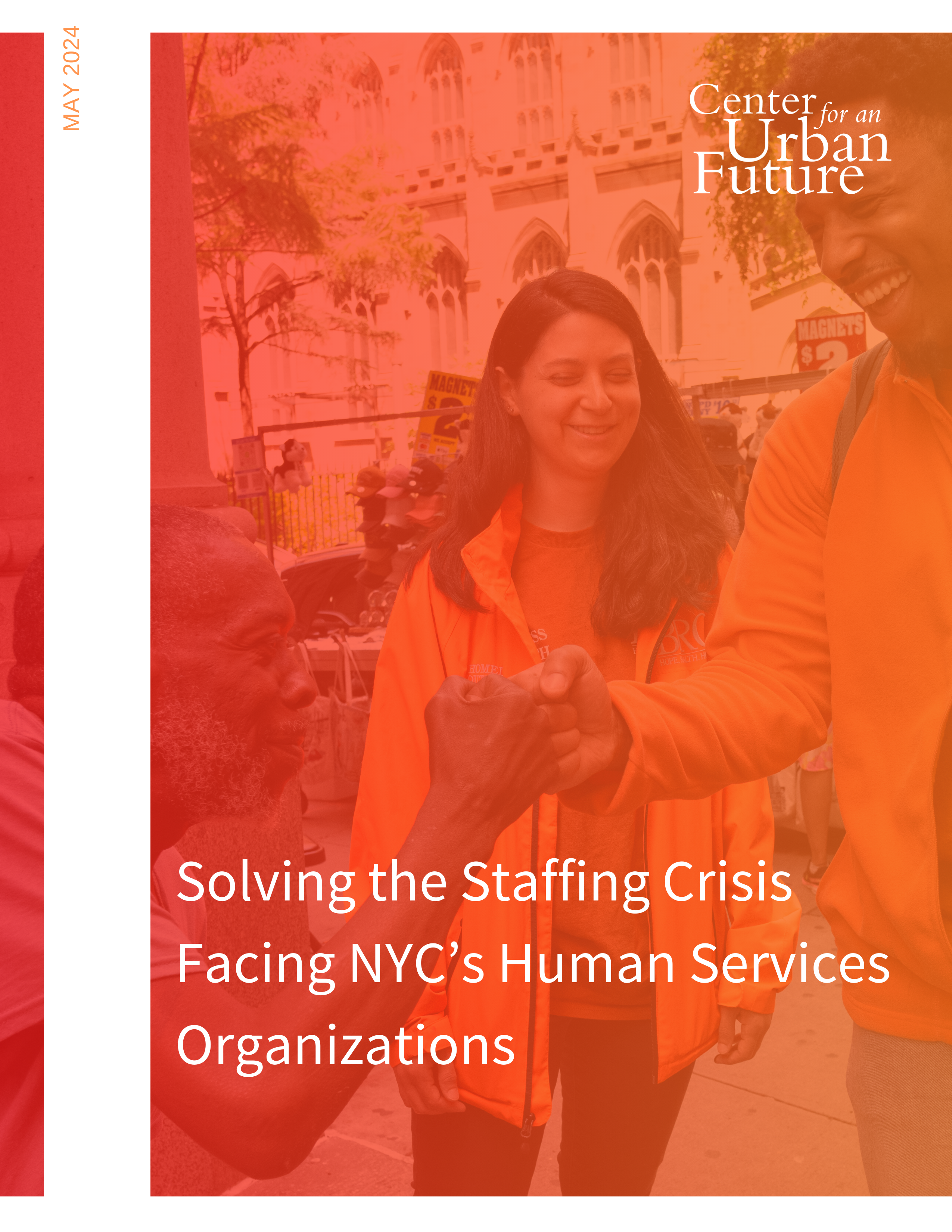Earlier this year, New York City government leaders took important steps to ensure that nonprofit organizations are paid in a timely manner for the vital safety net services that they provide. The commitment to clear a backlog of more than $4.2 billion in unpaid contracts and contract amendments promises to offer relief at a time when many human services organizations on the frontlines of the city’s pandemic response have themselves become financially vulnerable. But there is another important way city and state policymakers can help strengthen and stabilize the sector: by reducing the unnecessary administrative burdens government imposes on nonprofits.
From the registration process to systems for reporting on program outcomes, city and state contracts with human services nonprofits contain numerous requirements that are redundant, time-consuming, and unnecessarily complicated—and which cause nonprofits to divert exorbitant resources and staff time to filling out and filing paperwork. Hours that staff could spend delivering services out in their communities are instead spent in their offices, navigating antiquated, opaque, and maddeningly inconsistent bureaucratic systems that one executive described as “Kafkaesque.”
In nearly 40 interviews for this policy brief, leaders of human services organizations that work with numerous agencies, from DYCD to DFTA, DOE to DOC, described inefficiencies that broach the absurd. Uploading the same document to the same system 30 times—and then having to send it via email anyway. Hiring full-time staff to enter data into duplicative systems, instead of sorely needed case managers and paralegals. Scrambling to collect documents for dozens of audits in the same fiscal year only to be slapped with critical findings for purchases as minor as $11. Compiling 37 different documents to secure a $5,000 discretionary grant from a City Council member.
Navigating these unnecessarily complicated processes takes New York City’s nonprofit workforce—already overworked and underpaid—hundreds of thousands of hours annually and likely costs taxpayers millions of dollars, according to estimates and data gathered through interviews with sector leaders. By diverting so much time and so many resources, administrative burdens limit the scale and type of services nonprofits can provide at a moment of unprecedented need.
“Administrative burdens [force us] to divert resources, to create entire positions, just to deal with cumbersome processes,” says Maria Lizardo, executive director of the Northern Manhattan Improvement Corporation (NMIC), a social services organization based in Washington Heights and the south Bronx. “They hinder our ability to be strategic about the services we’re here to provide.”
An array of cumbersome processes at the city and state level need reform. This report identifies five of the most egregious ones currently imposed on nonprofits that could be reduced or eliminated without compromising accountability. It also lays out eight concrete, common-sense measures policymakers can take that could have an enormous impact on both nonprofit and city agency operations, saving staff time and taxpayer dollars. Combined with increased funding for nonprofits, such policy changes could offer urgently needed relief to the nonprofit sector and strengthen it long-term.
The Most Egregious Administrative Burdens Imposed on NYC’s Nonprofits
1. The contract registration process is still maddeningly inefficient and duplicative.
Over the past decade, city and state government have each introduced digital platforms designed to streamline and centralize the procurement or contracting process. New York State launched Grants Gateway in 2014 and New York City introduced HHS Accelerator and PASSPort (the Procurement and Sourcing Solutions Portal) in 2013 and 2017 respectively. HHS Accelerator persists primarily as a tool for managing program budget information, while PASSPort is used for most other aspects of the contracting process.
There is broad agreement among nonprofit leaders that these digital portals have been hugely important steps forward for modernizing archaic, paper-based procurement processes and standardizing practices across agencies, from issuing requests for proposals (RFPs) to registering contracts.
But despite the clear progress, our research reveals that there are still three major problems that limit the effectiveness of these digital procurement systems and result in unnecessary burdens for nonprofits.
First, several straggler agencies have yet to adopt the digital platforms. The NYC Department of Health and Mental Hygiene (DOHMH), for example, still does not use PASSPort, while New York State’s Office of Children and Family Services (OCFS) has not embraced Grants Gateway. Instead, these agencies have their own internal, often antiquated contracting procedures. For instance, Grants Gateway allows nonprofits to upload one set of documents that multiple state agencies will review as part of the contract application process, but nevertheless, OCFS still insists that nonprofits print and mail contract packets for each grant they have with that agency.
Second, the city and state agencies that have embraced PASSPort and Grants Gateway have not developed standard document requirements or conventions for formatting, naming, and uploading those documents—forcing nonprofits to dedicate staff time to navigating these inconsistent requirements, as well as to create and upload multiple iterations of essentially identical documents.
For example, staff at the Chinese-American Planning Council (CPC), which serves Asian American, immigrant, and low-income communities, must create and upload two different versions of their board of directors list for two different state agencies. While one agency requires each trustee’s name, address, email, current job title, and organization listed in that particular order, another agency requires each trustee’s name, position on the board, address, email, date of birth, and social security number.
To make matters worse, the use of these digital systems, in practice, too often undermines the goal of greater efficiency. For instance, even when properly formatted and named documents are made available on a digital platform like PASSPort, rather than accessing them there, agency staff frequently ask nonprofit staff to email them directly or upload them elsewhere. “We all need to be using the same system,” stresses Janelle Farris, president and executive director of Brooklyn Community Services, “so that it becomes routine to go to PASSPort first, before asking us to email documents that have been sitting in it for a year.”
Third, nonprofits that hold multiple contracts with the same agency are required to provide redundant documents for every contract every year.
For example, the youth-serving nonprofit Good Shepherd Services holds 25 contracts with the city’s Department of Youth and Community Development (DYCD), which means that staff currently must upload basic documents such as general liability information and the board of directors list—which seldom change—at least 25 times every year.
Likewise, staff at Heights and Hills, a nonprofit that supports older adults, are obligated to upload documents to PASSPort for every contract they hold with the Department for the Aging (DFTA)—even though the exact same documents were already uploaded to PASSPort for prior contracts or other contracts. “It’s a little ridiculous to upload documents into a system that already has them,” says Carrie Zwiebel Bloss, executive director of Heights and Hills. “It takes time to upload and slows down the processing of the contract, which costs us money and resources in other ways.”
The Mayor’s Office of Contract Services (MOCS) previously solved this problem with the “documents vault” feature on HSS Accelerator, which allowed nonprofits to upload basic documents and agency staff to easily access them. “That system worked so well,” remembers Dana Altneu, vice president of compliance, risk management, and government contracts at Good Shepherd Services. “It eliminated the issue of uploading the same document 100 times.” If PASSPort revived the documents vault feature—and it was universally adopted by agency staff—MOCS could eliminate an enormous amount of unnecessary work and correspondence.
2. Duplicative, fragmented reporting systems waste an inordinate amount of staff time and don’t produce useful data.
As part of their contracts with city and state agencies, human services organizations are required to report on program performance metrics and costs. However, there is currently no standardized, integrated reporting system at either the city or the state level. This creates two problems. First, nonprofit staff spend a massive amount of time entering duplicative data into multiple systems; second, these fragmented, stand-alone systems fail to generate useful, holistic data about the populations nonprofits are striving to serve.
In dozens of interviews, nonprofit leaders described the drain of data entry on their staff. Public Health Solutions (PHS), a nonprofit focused on health equity, estimates that, on average, their staff spend 20 to 30 percent of their total time at work entering data into at least 12 different systems—instead of spending face time with clients and community members.
“The duplication of data is overwhelming,” explains Frederick Shack of Urban Pathways. “We have a comprehensive digital case record that tracks clients across the sector, but the city requires our staff to input information into their different systems. [The Department of Homeless Services] has one; DOHMH has another one. To add insult to injury, they also require us to maintain a paper record of our own digital record for when they come to audit. Every hour, every minute that a worker isn’t able to go into the community and connect with a client, they’re sitting in their offices either filing or doing double data entry. It’s a major, major drain.”
“Double data [entry] is very demoralizing to the workforce when they want to spend the day serving people,” adds Ben Thomases of Queens Community House, which tracks participant data using its own Salesforce-based database and separately enters data into DFTA and DYCD’s databases. “Our human services workforce did not get into their jobs to spend the whole day in front of the computer entering data.”
Many nonprofits have hired full-time data entry staff to keep up—in lieu of hiring additional case managers, paralegals, or other roles that could provide highly sought-after direct services.
In addition to squandering staff resources and goodwill—and a significant share of operational dollars—fragmented government reporting systems fail to provide useful data. These stand-alone systems were designed to meet the standards of government accountability rather than generate data to inform social services. The systems are invisible to one another, meaning the same person may stay in temporary housing and attend early literacy classes with their child—but the separate reporting systems of the Department of Homeless Services (DHS) and DYCD would not capture this intersection. “City systems don’t track clients across programs,” Shack explains. “And it’s important for case managers to have a complete history of a client’s services.”
It's difficult, if not impossible, to extract data from these systems to inform services on the level of entire populations, let alone individual clients. Queens Community House, for example, cannot use the DFTA or DYCD data systems to generate reports needed to improve its programs, such as calculating the number of older adults who visit a center from a particular zip code, or cross-checking the addresses of participating older adults with children in their after-school programs to better understand how many older adults are acting as caregivers. To leverage useful data, Queens Community House, like Urban Pathways and other nonprofit organizations, is obliged to maintain its own internal data system using Salesforce software—and to raise private dollars to invest in technology that strengthens the design and delivery of contracted services.
Many organizations, however, lack the resources to maintain such internal systems while keeping pace with government reporting requirements—leaving their case managers and clients at a disadvantage. “We don’t have time to add information into an internal system after adding it into the various government-mandated reporting systems,” explains Zach Hennessey, vice president and chief strategy officer of PHS. “So our staff have no idea whether our clients who are served by WIC are also served by maternal child health or have SNAP benefits.”
To eliminate redundant data entry and better leverage data to improve human services, government agencies should import data from nonprofits via Excel templates, instead of requiring them to manually enter it, field by field, into different data systems. State and city leaders should also invest in building data bridges or application programming interfaces (APIs) that would allow nonprofits and government agencies to share data securely across systems.
3. The vouchering and reimbursement process requires excessive documentation and correspondence.
In order for nonprofits to get reimbursed by city agencies for costs they have incurred delivering services, those nonprofits are required to submit vouchers with documentation such as invoices, receipts, and other proof of payment. Such fiscal oversight measures are intended to prevent nonprofits from wasting public dollars—but over the years, these measures have become so excessive they now cause the very waste they were meant to prevent. An estimated tens of thousands of hours of staff time at both nonprofits and government agencies—and millions of taxpayer dollars—are spent compiling, reviewing, and haggling over vouchers, according to estimates and data gathered through interviews with sector leaders. While accountability is critical, the current process is far too slow and labor-intensive.
There is currently no standardized digital platform for submitting vouchers or tracking reimbursement payments. Each city and state agency dictates their own vouchering process, often with their own arcane documentation requirements. One agency, for example, requires nonprofits to mail original hardcopy invoices, rather than scanning and emailing them, while the Department for the Aging requires every check—no matter how small—to be signed by two nonprofit staff members. “Even if I write a check for $5.50, I need two people to sit down and sign that check,” says Carrie Zwiebel Bloss, executive director of Heights and Hills.
According to dozens of interviews, voucher documentation is routinely reviewed with the utmost skepticism and rejected on the grounds of seemingly miniscule technicalities. For example, the Osborne Association, which serves New Yorkers involved with the criminal justice system, submitted the receipt for new tires on a car used as part of its work with clients, but the Department of Corrections (DOC) refused to reimburse them on the grounds that the receipt did not include the car’s license plate number. “The amount of backup they ask for is insane,” says Elizabeth Gaynes, former CEO of the Osborne Association and senior advisor to the current CEO. “They trust us to do all this work, but they don’t trust we’re putting tires on the right car?”
Similarly, the nonprofit Greenwich House submitted a voucher which included “.00” after some but not all of the listed costs—i.e., $50 instead of $50.00. On these grounds, the voucher was initially rejected. Darren Bloch, CEO of Greenwich House, which offers arts and education programs as well as social services, estimates that his staff responds to five requests for clarification or revision each time they submit a voucher.
Even with a finance team of six full-time staff, Greenwich House found that it could not keep pace with the volume of administrative back and forth with DFTA and DOHMH at the city level and the Department of Health (DOH) and Office of Addiction Services and Supports (OASAS) on the state level. “We had to hire an external partner to do the vouchering work,” Bloch says. “We didn’t have the capacity to support that much churn.”
In addition to causing staff burnout, this churn is also extremely inefficient. “We’re spending $2,000 worth of staff time to get reimbursed for $500 worth of goods because we have a copy of the invoice instead of the original,” explains Ben Thomases of Queens Community House. “How much additional protection does an original invoice, versus an emailed scan of an invoice, provide the public against waste? The cost there is very, very high and the benefit is zero.”
In January 2021, the Mayor’s Office of Contract Services launched an initiative intended to streamline and speed up the voucher and reimbursement process. According to new guidelines, nonprofits are meant to be reimbursed within seven business days of submitting a voucher, after which a sample of expenses are to be audited, with any resulting payment disallowances deducted from the following voucher. The problem is that several city agencies have not been complying with the new guidelines. These agencies continue to audit expenses before issuing payment—a process that takes significantly longer than seven days.
All agencies at the city and state level should be held accountable for consistently processing vouchers and issuing payments in a timely manner. This could be accomplished by launching digital vouchering and payment portals at the city and state levels, potentially as part of PASSPort or Grants Gateway. These portals would require standardized documentation and the review process would correlate with the amount of the expense, so that $55,000 purchases would receive more scrutiny than $5,500—or $5.50—purchases. This process could be further improved through the use of artificial intelligence, a technology already widely used in banking, to automatically review voucher claims below a certain threshold, as is already the case for many mobile bank deposits today.
4. Excessive auditing is a drain on nonprofit staff and government resources.
In a typical year, nonprofits that hold contracts with government agencies receive multiple audits in addition to the independent, in-house audits they conduct to fulfill their own fiduciary responsibilities. In contrast with federal auditing guidelines, which require testing 15 to 20 percent of contracts, certain agencies at the local and state levels test 100 percent of contracts, meaning nonprofits routinely receive audits for every contract they hold with a particular agency. Good Shepherd Services holds 25 contracts with DYCD and receives audits every year for all 25 contracts.
Such frequent, extensive auditing is extremely costly to both government and the nonprofit sector. Government agencies hire private firms with steep hourly rates to conduct the audits, while nonprofit staff spend extensive time gathering, formatting, and sharing the necessary documents with auditors, and responding to their inquiries and findings. Each audit requires preparation and usually takes place on-site over the course of several days, pulling nonprofit staff away from other duties.
For every audited contract, nonprofit staff must submit the same baseline documents which seldom change over time, such as their organization’s personnel manual, organization chart, and board meeting minutes. If the formatting and naming conventions were standardized, and these documents were readily, digitally accessible to auditing firms on PASSPort and Grants Gateway, it would save nonprofit staff from printing thousands of redundant documents or attaching them to thousands of individual emails.
As state and local government currently have different auditing standards, nonprofit staff are often forced to present the same information in different formats. While the nonprofit Asian Americans for Equality (AAFE) lists the costs of its housing program staff under the broader “housing department” line item to meet state auditing standards, city standards require the organization to list every single staff title, from porters to building managers. Auditing standards also differ between government agencies and auditing firms, and also shift over time.
“Year after year, the standards of the auditing processes vary depending on the firm who’s auditing,” explains Jeehae Fischer, executive director of the Korean American Family Service Center. “One year, we had findings about one particular issue, which we prepared for the following year. But that year, the focus was something else. Our staff are spending a lot of time preparing these documents, but it’s confusing, and year after year we are unsure how to prepare.”
Audit findings can feel like ironic reprimands to nonprofit organizations that routinely receive payments from government agencies months or even years later than promised. Whereas nonprofits are issued audit findings for every late payment, there is no comparable accountability mechanism for government agencies. “We would sometimes get emails we were 45 or 95 days late issuing a payment,” recalls a former analyst at the NYC Office of Management and Budget (OMB), who requested anonymity in order to speak freely about their former employer. “But there was no accountability for us. That wasn’t even factored into our performance evaluations.”
Nonprofits, on the other hand, are issued audit findings for every late payment, and for errors as minor as $11. Reviewing and responding to such findings is time-intensive and wildly inefficient, not to mention demoralizing. “It costs so much more than $11 for a private audit firm to write down that finding and for my staff to respond to it,” says Ben Thomases of Queens Community House. “It’s a remarkably wasteful process.”
5. Discretionary funding applications and reporting requirements create more work for nonprofits than the grants are often worth.
Many of New York City’s smaller, more fiscally vulnerable nonprofits do not have the capacity to compete for RFPs from city agencies and keep up with the subsequent reporting requirements. These organizations disproportionately rely on discretionary funding from City Council members—a funding mechanism created, in part, to sidestep the pitfalls of city contracts. Theoretically, the application process is easier, the funds are delivered faster, and the reporting requirements are simpler. However, in practice, the process of securing funds from City Council has become increasingly burdensome as new requirements have been layered on in recent years.
For example, when the education nonprofit BEAM (Bridge to Enter Advanced Mathematics) was awarded $5,000 in discretionary funding, the organization discovered that it needed to submit 37 documents in order to process the contract, including several that required notarization. “It probably costs BEAM nearly as much in time to collect all the paperwork as our contract is worth, and burdens multiple staff members,” recalls Melissa Gillis, BEAM’s director of advancement. “It seemed that no matter what we submitted, they always came back wanting additional information.” The process was so labor intensive and therefore costly that BEAM leadership has decided not to pursue discretionary funding in the future.
Such hoops pose challenges even for large nonprofits with more capacity and institutional knowledge about how to navigate government bureaucracy. “Discretionary funding slows everything else down,” says Michelle Yanche of Good Shepherd Services. “Five thousand dollars in discretionary funding will hold up a $10,000 after-school contract from getting processed.”
Once nonprofits receive discretionary funds, the ensuing reporting requirements often prove just as burdensome as application requirements. Whereas in the past, Asian Americans for Equality was required to report on the small business loans they made according to city council districts’ geographical constituencies, in FY2022 the reporting requirements changed, and now AAFE is required to report on each individual small business loan—a huge additional administrative burden for an organization processing up to 250 loans a year.
Many members of the City Council are already aware that discretionary funding reform is urgently needed. “When you’ve been allotted $10,000 in discretionary funds, it is not okay to have a nonprofit with 30 employees dedicate two of those employees to it for weeks at a time,” says Council Member Julie Won, speaking during a recent CUF forum. “We’ve created such an administrative burden for only $10,000, which isn’t even enough to cover one payroll.”
If the City Council, MOCS, and the New York City Comptroller’s Office worked together to pare down discretionary funding requirements, they could create a more efficient, timely funding stream—and bolster New York’s most vulnerable nonprofits and the communities they serve.






